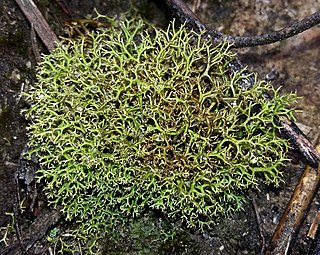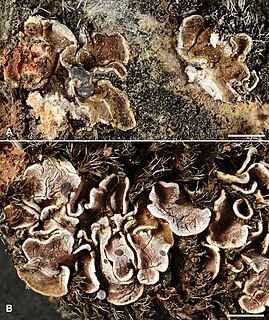
Lichenomphalia is both a basidiolichen and an agaric genus. Most of the species have inconspicuous lichenized thalli that consist of scattered, small, loose, nearly microscopic green balls or foliose small flakes containing single-celled green algae in the genus Coccomyxa, all interconnected by a loose network of hyphae. The agaric fruit bodies themselves are nonlichenized and resemble other types of omphalinoid mushrooms. These agarics lack clamp connections and do not form hymenial cystidia. The basidiospores are hyaline, smooth, thin-walled, and nonamyloid. Most of the species were originally classified in the genera Omphalina or Gerronema. Historically the species were classified with those other genera in the family, the Tricholomataceae together with the nonlichenized species. Lichenomphalia species can be grouped into brightly colored taxa, with vivid yellow and orange colors, versus the grey brown group, depending upon the microscopic pigmentation deposits. Molecular research comparing DNA sequences now place Lichenomphalia close to the redefined genus Arrhenia, which together with several other genera not traditionally considered to be related, fall within the newly redefined Hygrophoraceae.

Hygrocybe miniata, commonly known as the vermilion waxcap, is a small, bright red or red-orange mushroom of the waxcap genus Hygrocybe. It is a cosmopolitan species, that is found worldwide. In Europe, it is found in fields, on sandy heaths, or grassy commons in the autumn. It is found in rainforest and eucalypt forest as well as heathland in Australia.

Cladia is a genus of lichenized fungi in the family Cladoniaceae. Cladia species have a crustose primary thallus and a fruticose, secondary thallus, often referred to as pseudopodetium. The type species of the genus, Cladia aggregata, is widely distributed, occurring from South America, South Africa, Australasia and South-East Asia to southern Japan and India. Most of the other species are found in the Southern Hemisphere.

Acarospora is a genus of lichenized fungi in the family Acarosporaceae. Most species in the genus are crustose lichens that grow on rocks in open and arid places all over the world. They may look like a cobblestone road or cracked up old paint, and are commonly called cobblestone lichens or cracked lichens,. They usually grow on rock, but some grow on soil (terricolous) or on other lichens. Some species in the genus are fungi that live as parasites on other lichens. Acarospora is a widely distributed genus, with about 128 species according to a 2008 estimate.

Gymnopilus maritimus is a fungus species of the family Cortinariaceae first collected in northern Sardinia, Italy, in 2006. The species produces moderately sized, sturdy mushrooms of a reddish-orange colour. The cap, which can measure up to 70 millimetres (3 in) across, is covered in orange fibrils, and sometimes has small scales. The yellowish stem measures up to 110 mm (4 in) in length by 8 mm (0.3 in) in width, and sometimes shows remnants of the partial veil. The mushrooms have thick gills of a variable colour, ranging from yellow to rust but staining darker, and the yellow flesh has a mild taste. The mushrooms leave a rusty-brown spore print, while the spores themselves measure from 7.5–11.5 micrometres (0.00030–0.00045 in) in length. The species is most similar in appearance to G. arenophilus and G. fulgens, but can be differentiated from both morphologically. Despite the similarities, it is not closely related to either, suggesting convergent evolution. Instead, within the genus Gymnopilus, it is most closely related to the spectabilis–imperialis clade. However, it is not particularly similar to any of its closest relatives.
Acarospora flavisparsa is a species of lichen in the family Acarosporaceae. Found in Portugal and Spain, it was described as new to science in 2011. The lichen grows on acidic rock walls in inland areas.
Punctelia transtasmanica is a species of foliose lichen in the family Parmeliaceae. It is found in Australasia.

Trapeliopsis steppica is a species of squamulose lichen in the family Trapeliaceae. It is found in the western United States, where it grows on soil in grassland and in shrub–steppe.
Menegazzia subtestacea is a species of foliose lichen in the family Parmeliaceae. It is found in Tasmania (Australia), where it grows at high elevations on the twigs and young branches of alpine shrubs.
Menegazzia tarkinea is a rare species of foliose lichen in the family Parmeliaceae. It occurs in North West Tasmania (Australia).
Menegazzia bjerkeana is a rare species of foliose lichen in the family Parmeliaceae. It occurs in rainforests along the New South Wales-Queensland border, where it grows on the bark of southern beech trees.
Lichenomphalia altoandina is a species of basidiolichen in the family Hygrophoraceae. Found in Chile, it was described as a new species in 2017 by Pablo Sandoval-Leiva and Nicolas Niveiro.

Lichenomphalia chromacea is a species of basidiolichen in the family Hygrophoraceae. It is found in southern Australia. The yellow-orange fruiting bodies of the species are mushroom-like, with a cap width of typically less than 4 cm. The thallus of the lichen is a greenish, granular layer of fungal hyphae and algae on the soil around the base of the stipe.
Lichenomphalia cinereispinula is a species of basidiolichen in the family Hygrophoraceae. Found in Europe, it was described as a new species in 2009 by Pierre Neville and Francis Fouchier. The type specimen was collected at a place called "La Rivière", in the commune of Collobrières; here it was found growing on the ground at an altitude of 135 m (443 ft).
Cladonia lichexanthonica is a rare species of saxicolous (rock-dwelling) lichen in the family Cladoniaceae. Found in Bahia, Brazil, it was formally described as a new species in 2018 by lichenologists André Aptroot and Marcela Eugenia da Silva Cáceres. The type specimen was collected by the authors from the Morro do Pai Inácio at an altitude between 1,050 and 1,140 m ; here the lichen was found growing on siliceous sandstone rock in a transitional forest. Cladonia lichexanthonica is only known to occur at the type locality, and is only known from the type specimen. The lichen has a squamulose (scaley) thallus measuring up to 10 cm (4 in) in diameter; this consists of a 5-millimetre (0.2 in) thick crust comprising individual crowded squamules, pale-olive green to olive brown, measuring 1–5 mm in size. The specific epithet lichexanthonica refers to the presence of lichexanthone, a secondary compound that was not previously known to occur in genus Cladonia.
Parmeliella triptophylloides is a species of corticolous (bark-dwelling) lichen in the family Pannariaceae. Found in east Africa, it was formally described as a new species in 2003 by Norwegian lichenologist Per Magnus Jørgensen. The type specimen was collected by Dutch mycologist Rudolf Arnold Maas Geesteranus in 1949, from the Cherang'any Hills at an elevation of 900 m (3,000 ft). In addition to the type locality, it has also been recorded from the Luhangalo Plateau in Tanzania.
Caloplaca tephromelae is a species of lichenicolous (lichen-eating) lichen in the family Teloschistaceae. Found in Australia, it was formally described as a new species in 2021 by Gintaras Kantvilas, Ave Suija, and Jurga Motiejūnaitė. The type specimen was collected from the northern rim of Callitris Gully ; here it was found growing on the thallus of the lichen Tephromela atra, which itself was growing on dolerite outcrops. Caloplaca tephromelae is only known to occur at the type locality. It appears as whitish areolate sections, outlined by a dark band of prothallus, growing within the thallus of its host lichen. Another recorded host is Tephromela granularis. The specific epithet tephromelae refers to the genus of the host.
Lecanora panticapaensis is a species of saxicolous (rock-dwelling), crustose lichen in the family Lecanoraceae. It occurs in a single locality in Dnipropetrovsk Oblast, Ukraine, where it grows on the vertical surfaces of black schist beside a river.

Psora taurensis is a species of terricolous (ground-dwelling), squamulose lichen in the family Lecanoraceae. It is found in the Taurus Mountains of Turkey.
Leucocoprinus tricolor is a species of mushroom producing fungus in the family Agaricaceae.







